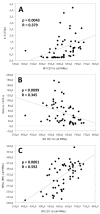Association of Circulating Neutrophils with Relative Volume of Lipid-Rich Necrotic Core of Coronary Plaques in Stable Patients: A Substudy of SMARTool European Project
- PMID: 36836785
- PMCID: PMC9958623
- DOI: 10.3390/life13020428
Association of Circulating Neutrophils with Relative Volume of Lipid-Rich Necrotic Core of Coronary Plaques in Stable Patients: A Substudy of SMARTool European Project
Abstract
Background and aims: Coronary atherosclerosis is a chronic non-resolving inflammatory process wherein the interaction of innate immune cells and platelets plays a major role. Circulating neutrophils, in particular, adhere to the activated endothelium and migrate into the vascular wall, promoting monocyte recruitment and influencing plaque phenotype and stability at all stages of its evolution. We aimed to evaluate, by flow cytometry, if blood neutrophil number and phenotype-including their phenotypic relationships with platelets, monocytes and lymphocytes-have an association with lipid-rich necrotic core volume (LRNCV), a generic index of coronary plaque vulnerability, in a group of stable patients with chronic coronary syndrome (CCS).
Methods: In 55 patients, (68.53 ± 1.07 years of age, mean ± SEM; 71% male), the total LRNCV in each subject was assessed by a quantitative analysis of all coronary plaques detected by computed tomography coronary angiography (CTCA) and was normalized to the total plaque volume. The expression of CD14, CD16, CD18, CD11b, HLA-DR, CD163, CCR2, CCR5, CX3CR1, CXCR4 and CD41a cell surface markers was quantified by flow cytometry. Adhesion molecules, cytokines and chemokines, as well as MMP9 plasma levels, were measured by ELISA.
Results: On a per-patient basis, LRNCV values were positively associated, by a multiple regression analysis, with the neutrophil count (n°/µL) (p = 0.02), neutrophil/lymphocyte ratio (p = 0.007), neutrophil/platelet ratio (p = 0.01), neutrophil RFI CD11b expression (p = 0.02) and neutrophil-platelet adhesion index (p = 0.01). Significantly positive multiple regression associations of LRNCV values with phenotypic ratios between neutrophil RFI CD11b expression and several lymphocyte and monocyte surface markers were also observed. In the bivariate correlation analysis, a significantly positive association was found between RFI values of neutrophil-CD41a+ complexes and neutrophil RFI CD11b expression (p < 0.0001).
Conclusions: These preliminary findings suggest that a sustained increase in circulating neutrophils, together with the up-regulation of the integrin/activation membrane neutrophil marker CD11b may contribute, through the progressive intra-plaque accumulation of necrotic/apoptotic cells exceeding the efferocytosis/anti-inflammatory capacity of infiltrating macrophages and lymphocytes, to the relative enlargement of the lipid-rich necrotic core volume of coronary plaques in stable CAD patients, thus increasing their individual risk of acute complication.
Keywords: coronary CT angiography; coronary artery disease; cytokines; flow cytometry; lipid-rich necrotic core volume; neutrophils; platelets.
Conflict of interest statement
The authors declare no conflict of interest.
Figures


Similar articles
-
Blood M2-like Monocyte Polarization Is Associated with Calcific Plaque Phenotype in Stable Coronary Artery Disease: A Sub-Study of SMARTool Clinical Trial.Biomedicines. 2022 Feb 28;10(3):565. doi: 10.3390/biomedicines10030565. Biomedicines. 2022. PMID: 35327367 Free PMC article.
-
Blood Monocyte Phenotype Fingerprint of Stable Coronary Artery Disease: A Cross-Sectional Substudy of SMARTool Clinical Trial.Biomed Res Int. 2020 Jul 27;2020:8748934. doi: 10.1155/2020/8748934. eCollection 2020. Biomed Res Int. 2020. PMID: 32802883 Free PMC article. Clinical Trial.
-
Post-reperfusion changes of monocyte function in coronary blood after extracorporeal circulation.Cytometry B Clin Cytom. 2005 May;65(1):14-21. doi: 10.1002/cyto.b.20049. Cytometry B Clin Cytom. 2005. PMID: 15786508
-
Neutrophil/Lymphocyte ratio is associated with non-calcified plaque burden in patients with coronary artery disease.PLoS One. 2014 Sep 30;9(9):e108183. doi: 10.1371/journal.pone.0108183. eCollection 2014. PLoS One. 2014. PMID: 25268632 Free PMC article.
-
Chimeric 7E3 Fab (ReoPro) decreases detectable CD11b on neutrophils from patients undergoing coronary angioplasty.J Am Coll Cardiol. 1999 Jan;33(1):97-106. doi: 10.1016/s0735-1097(98)00532-4. J Am Coll Cardiol. 1999. PMID: 9935015
Cited by
-
Novel Biomarkers and Imaging Indices for the "Vulnerable Patient" with Carotid Stenosis: A Single-Center Study.Biomolecules. 2023 Sep 21;13(9):1427. doi: 10.3390/biom13091427. Biomolecules. 2023. PMID: 37759829 Free PMC article.
References
-
- Sbrana S., Campolo J., Clemente A., Bastiani L., Cecchettini A., Ceccherini E., Caselli C., Neglia D., Parodi O., Chiappino D., et al. Blood monocyte phenotype fingerprint of stable coronary artery disease: A cross-sectional substudy of SMARTool clinical Trial. BioMed Res. Int. 2020;2020:8748934. doi: 10.1155/2020/8748934. - DOI - PMC - PubMed
-
- Sbrana S., Cecchettini A., Bastiani L., Di Giorgi N., Mazzone A., Ceccherini E., Vozzi F., Caselli C., Neglia D., Clemente A., et al. Bood M2-like monocyte polarization is associated with calcific plaque phenotype in stable coronary artery disease: A sub-study of SMARTool clinical trial. Biomedicines. 2022;10:565. doi: 10.3390/biomedicines10030565. - DOI - PMC - PubMed
Grants and funding
LinkOut - more resources
Full Text Sources
Research Materials
Miscellaneous

